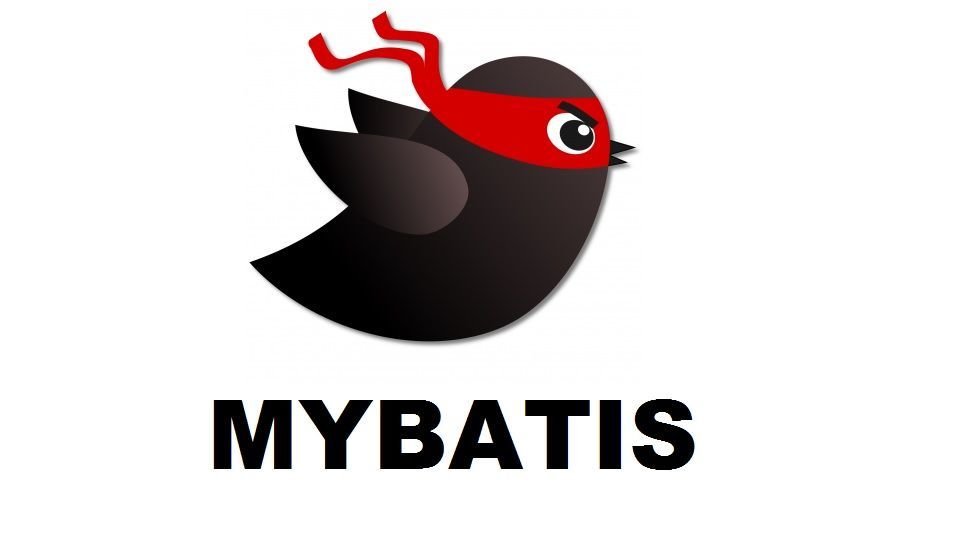
MyBatis源码分析(四)插件拦截器的原理及使用
一般开源框架都会提供扩展点,让开发者自行扩展,从而完成逻辑的增强。基于插件机制可以实现了很多有用的功能,比如说分页,字段加密,监控等功能,这种通用的功能,就如同AOP一样,横切在数据操作上。而通过Mybatis插件可以实现对框架的扩展,来实现自定义功能,并且对于用户是无感知的。Mybatis插件本质上来说就是一个拦截器,它体现了 JDK动态代理和责任链设计模式的综合运用。
系列文章索引
MyBatis源码分析(一)MyBatis整体架构分析
MyBatis源码分析(二)SqlSessionFactory的构建及配置文件读取过程
MyBatis源码分析(二、续)SqlSource创建流程,SQL如何解析?如何将#{id}变成?的
MyBatis源码分析(三)SqlSession的执行主流程
MyBatis源码分析(四)插件拦截器的原理及使用
MyBatis源码分析(四、续)MyBatis分页插件拦截器设计与实现
MyBatis源码分析(五)一级缓存与二级缓存的原理
MyBatis源码分析(六)MetaObject工具类的使用与源码分析
MyBatis源码分析(七)MyBatis与Spring的整合原理与源码分析
深入理解JDK动态代理原理,使用javassist动手写一个动态代理框架
一、初识MyBatis拦截器插件
1、前置知识:两种拦截器
拦截器其实有两种实现方式,一种是可以从中间截断;另一种是不能从中间截断,只能在中间过程中对数据进行增强或处理。
(1)第一种拦截器
这种拦截器不能从中截断停止后面的拦截器执行,只能在过程中对目标对象进行增强处理。
import java.util.ArrayList;
import java.util.List;
public class InterceptorDemo {
public static void main(String[] args) {
InterceptorA interceptorA = new InterceptorA();
InterceptorB interceptorB = new InterceptorB();
InterceptorChain interceptorChain = new InterceptorChain();
interceptorChain.addInterceptor(interceptorA);
interceptorChain.addInterceptor(interceptorB);
interceptorChain.pluginAll(new Object()); // 依次执行A、B
}
}
interface Interceptor {
Object plugin(Object target);
}
class InterceptorA implements Interceptor {
@Override
public Object plugin(Object target) {
System.out.println("InterceptorA");
return target;
}
}
class InterceptorB implements Interceptor {
@Override
public Object plugin(Object target) {
System.out.println("InterceptorB");
return target;
}
}
class InterceptorChain {
List<Interceptor> interceptors = new ArrayList<>();
public void addInterceptor(Interceptor interceptor) {
interceptors.add(interceptor);
}
public Object pluginAll(Object target) {
for (Interceptor interceptor : interceptors) {
target = interceptor.plugin(target);
}
return target;
}
}
(2)第二种拦截器
这种拦截器可以在中间截断,后续的拦截器不会再执行。
import java.util.ArrayList;
import java.util.Iterator;
import java.util.List;
public class InterceptorDemo {
public static void main(String[] args) {
InterceptorA interceptorA = new InterceptorA();
InterceptorB interceptorB = new InterceptorB();
InterceptorChain interceptorChain = new InterceptorChain();
interceptorChain.addInterceptor(interceptorA);
interceptorChain.addInterceptor(interceptorB);
interceptorChain.plugin(new Object());
}
}
interface Interceptor {
Object plugin(Object target, InterceptorChain chain);
}
class InterceptorA implements Interceptor {
@Override
public Object plugin(Object target, InterceptorChain chain) {
System.out.println("InterceptorA");
//return chain.plugin(target);
return target; // 后续的拦截器不会被执行
}
}
class InterceptorB implements Interceptor {
@Override
public Object plugin(Object target, InterceptorChain chain) {
System.out.println("InterceptorB");
return chain.plugin(target);
}
}
class InterceptorChain {
List<Interceptor> interceptors = new ArrayList<>();
private Iterator<Interceptor> iterator;
public void addInterceptor(Interceptor interceptor) {
interceptors.add(interceptor);
}
public Object plugin(Object target) {
if(iterator == null){
iterator = interceptors.iterator();
}
if(iterator.hasNext()) {
Interceptor next = iterator.next();
next.plugin(target, this);
}
return target;
}
}
2、什么是Mybatis插件
一般开源框架都会提供扩展点,让开发者自行扩展,从而完成逻辑的增强。
基于插件机制可以实现了很多有用的功能,比如说分页,字段加密,监控等功能,这种通用的功能,就如同AOP一样,横切在数据操作上。
而通过Mybatis插件可以实现对框架的扩展,来实现自定义功能,并且对于用户是无感知的。
Mybatis插件本质上来说就是一个拦截器,它体现了 JDK动态代理和责任链设计模式的综合运用。
3、MyBatis插件支持的扩展接口
Mybatis中针对四大组件提供了扩展机制,这四个组件分别是:
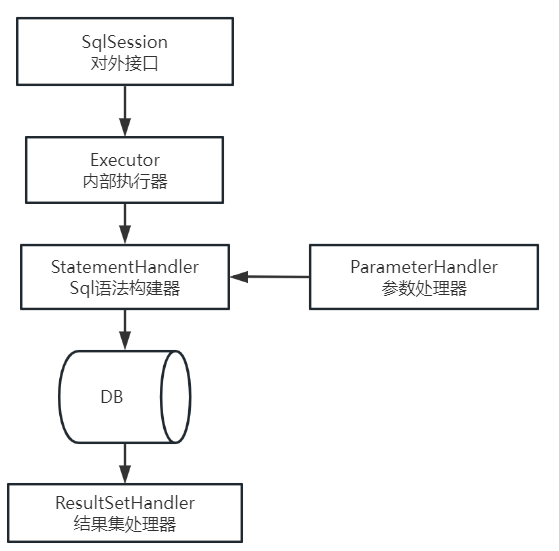
Mybatis中所允许拦截的方法如下:
Executor 【SQL执行器】【update,query,commit,rollback】
StatementHandler 【Sql语法构建器对象】【prepare,parameterize,batch,update,query等】
ParameterHandler 【参数处理器】【getParameterObject,setParameters等】
ResultSetHandler 【结果集处理器】【handleResultSets,handleOuputParameters等】
这些类中方法的细节可以通过查看每个方法的签名来发现,或者直接查看 MyBatis 发行包中的源代码。 如果你想做的不仅仅是监控方法的调用,那么你最好相当了解要重写的方法的行为。 因为在试图修改或重写已有方法的行为时,很可能会破坏 MyBatis 的核心模块。 这些都是更底层的类和方法,所以使用插件的时候要特别当心。
4、能干什么
分页功能:mybatis的分页默认是基于内存分页的(查出所有,再截取),数据量大的情况下效率较低,不过使用mybatis插件可以改变该行为,只需要拦截StatementHandler类的prepare方法,改变要执行的SQL语句为分页语句即可。
性能监控:对于SQL语句执行的性能监控,可以通过拦截Executor类的update, query等方法,用日志记录每个方法执行的时间。
二、拦截器插件初体验
通过 MyBatis 提供的强大机制,使用插件是非常简单的,只需实现 Interceptor 接口,并指定想要拦截的方法签名即可。
1、创建Interceptor的实现类
import org.apache.ibatis.executor.statement.StatementHandler;
import org.apache.ibatis.mapping.BoundSql;
import org.apache.ibatis.plugin.Interceptor;
import org.apache.ibatis.plugin.Invocation;
import org.apache.ibatis.plugin.Plugin;
import java.util.Properties;
/**
* 使用@Intercepts注解完成插件签名 说明插件的拦截四大对象之一的哪一个对象的哪一个方法
*/
@Intercepts({ @Signature(type = StatementHandler.class,
method = "prepare",
args = { Connection.class, Integer.class}) })
public class MyPlugin implements Interceptor {
// //这里是每次执行操作的时候,都会进行这个拦截器的方法内
@Override
public Object intercept(Invocation invocation) throws Throwable {
//增强逻辑
StatementHandler statementHandler = (StatementHandler) invocation.getTarget();
BoundSql boundSql = statementHandler.getBoundSql();
String sql = boundSql.getSql();
System.out.println(String.format("mybatis intercept sql:{}", sql));
return invocation.proceed(); //执行原方法
}
/**
*
* Description包装目标对象 为目标对象创建代理对象
* @Param target为要拦截的对象
* @Return代理对象
*/
@Override
public Object plugin(Object target) {
System.out.println("将要包装的目标对象:" + target);
return Plugin.wrap(target, this);
}
/**获取配置文件的属性**/
//插件初始化的时候调用,也只调用一次,插件配置的属性从这里设置进来
@Override
public void setProperties(Properties properties) {
System.out.println("插件配置的初始化参数:" + properties);
}
}
2、配置插件
将写好的插件注册到全局配置文件中。
<!-- mybatis-config.xml -->
<?xml version="1.0" encoding="UTF-8" ?>
<!DOCTYPE configuration PUBLIC "-//mybatis.org//DTD Config 3.0//EN"
"http://mybatis.org/dtd/mybatis-3-config.dtd">
<configuration>
<plugins>
<plugin interceptor="com.demo.interceptor.MyPlugin">
<property name="dialect" value="mysql" /> <!-- 配置拦截器时自定义的参数 -->
</plugin>
</plugins>
</configuration>
三、原理及源码分析
1、拦截器的配置
我们可以在XML中使用plugin标签来配置拦截器:
<!-- mybatis-config.xml -->
<?xml version="1.0" encoding="UTF-8" ?>
<!DOCTYPE configuration PUBLIC "-//mybatis.org//DTD Config 3.0//EN"
"http://mybatis.org/dtd/mybatis-3-config.dtd">
<configuration>
<plugins>
<plugin interceptor="com.demo.interceptor.MyPlugin">
<property name="dialect" value="mysql" /> <!-- 配置拦截器时自定义的参数 -->
</plugin>
</plugins>
</configuration>
也可以通过API的方式,获取Configuration,通过addInterceptor方法添加拦截器。
configuration.addInterceptor(interceptor);
(1)XML配置拦截器原理
在构建SqlSessionFactory时,会对XML配置文件中的configuration标签进行解析:
// org.apache.ibatis.builder.xml.XMLConfigBuilder#parseConfiguration
private void parseConfiguration(XNode root) {
try {
// issue #117 read properties first
propertiesElement(root.evalNode("properties"));
Properties settings = settingsAsProperties(root.evalNode("settings"));
loadCustomVfs(settings);
loadCustomLogImpl(settings);
typeAliasesElement(root.evalNode("typeAliases"));
pluginElement(root.evalNode("plugins")); // 处理拦截器
objectFactoryElement(root.evalNode("objectFactory"));
objectWrapperFactoryElement(root.evalNode("objectWrapperFactory"));
reflectorFactoryElement(root.evalNode("reflectorFactory"));
settingsElement(settings);
// read it after objectFactory and objectWrapperFactory issue #631
environmentsElement(root.evalNode("environments"));
databaseIdProviderElement(root.evalNode("databaseIdProvider"));
typeHandlerElement(root.evalNode("typeHandlers"));
mapperElement(root.evalNode("mappers"));
} catch (Exception e) {
throw new BuilderException("Error parsing SQL Mapper Configuration. Cause: " + e, e);
}
}
其中pluginElement方法就是处理plugins标签,对拦截器进行配置:
// org.apache.ibatis.builder.xml.XMLConfigBuilder#pluginElement
private void pluginElement(XNode parent) throws Exception {
if (parent != null) {
for (XNode child : parent.getChildren()) {
// 获取拦截器
String interceptor = child.getStringAttribute("interceptor");
// 获取配置的Properties属性
Properties properties = child.getChildrenAsProperties();
// 根据配置文件中配置的插件类的全限定名 进行反射初始化
Interceptor interceptorInstance = (Interceptor) resolveClass(interceptor).getDeclaredConstructor().newInstance();
// 将属性添加到Intercepetor对象
interceptorInstance.setProperties(properties);
// 添加到配置类的InterceptorChain属性,InterceptorChain类维护了一个List<Interceptor>
configuration.addInterceptor(interceptorInstance);
}
}
}
主要做了以下工作:
- 遍历解析plugins标签下每个plugin标签
- 根据解析的类信息创建Interceptor对象
- 调用setProperties方法设置属性
- 将拦截器添加到Configuration类的IntercrptorChain拦截器链中
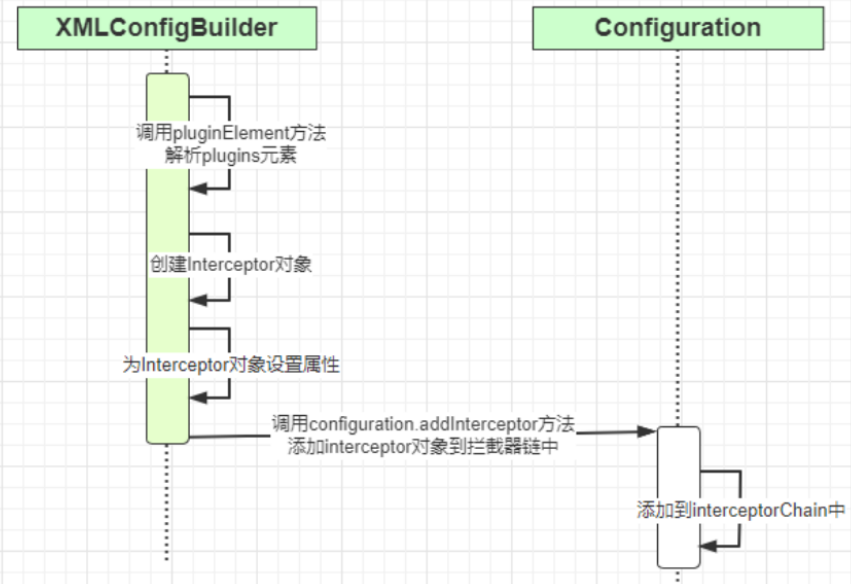
(2)API方式配置拦截器
API方式配置拦截器就是相当于省略一步XML的配置,需要手动创建Interceptor并且设置Property,然后通过Configuration的addInterceptor方法将拦截器加入到拦截器链中。
2、核心思想
就是使用JDK动态代理的方式,对这四个对象进行包装增强。具体的做法是,创建一个类实现Mybatis的拦截器接口,并且加入到拦截器链中,在创建核心对象的时候,不直接返回,而是遍历拦截器链,把每一个拦截器都作用于核心对象中。这么一来,Mybatis创建的核心对象其实都是代理对象,都是被包装过的。
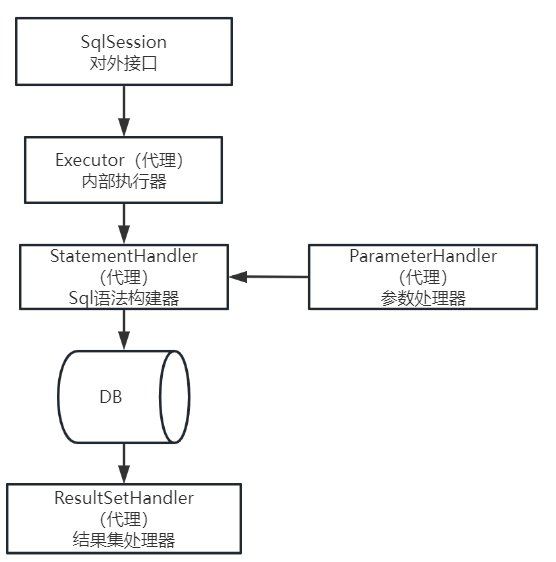
3、了解JDK动态代理
如果不了解JDK动态代理的,请自行百度学习~
4、源码分析
(1)拦截器链
MyBatis的所有拦截器都会存储在连接器链InterceptorChain中,在InterceptorChain中使用一个List存储着Interceptor:
public class InterceptorChain {
private final List<Interceptor> interceptors = new ArrayList<>();
// 将目标类进行代理
public Object pluginAll(Object target) {
for (Interceptor interceptor : interceptors) {
target = interceptor.plugin(target);
}
return target;
}
public void addInterceptor(Interceptor interceptor) {
interceptors.add(interceptor);
}
public List<Interceptor> getInterceptors() {
return Collections.unmodifiableList(interceptors);
}
}
InterceptorChain拦截器链的pluginAll方法是关键方法,将传入的对象进行代理。
(2)被代理的接口
我们看一下pluginAll方法都被哪里调用,都是在Configuration中创建Handler接口时调用的:
public ParameterHandler newParameterHandler(MappedStatement mappedStatement, Object parameterObject, BoundSql boundSql) {
ParameterHandler parameterHandler = mappedStatement.getLang().createParameterHandler(mappedStatement, parameterObject, boundSql);
// 代理ParameterHandler
parameterHandler = (ParameterHandler) interceptorChain.pluginAll(parameterHandler);
return parameterHandler;
}
public ResultSetHandler newResultSetHandler(Executor executor, MappedStatement mappedStatement, RowBounds rowBounds, ParameterHandler parameterHandler,
ResultHandler resultHandler, BoundSql boundSql) {
ResultSetHandler resultSetHandler = new DefaultResultSetHandler(executor, mappedStatement, parameterHandler, resultHandler, boundSql, rowBounds);
// 代理ResultSetHandler
resultSetHandler = (ResultSetHandler) interceptorChain.pluginAll(resultSetHandler);
return resultSetHandler;
}
public StatementHandler newStatementHandler(Executor executor, MappedStatement mappedStatement, Object parameterObject, RowBounds rowBounds, ResultHandler resultHandler, BoundSql boundSql) {
StatementHandler statementHandler = new RoutingStatementHandler(executor, mappedStatement, parameterObject, rowBounds, resultHandler, boundSql);
// 代理StatementHandler
statementHandler = (StatementHandler) interceptorChain.pluginAll(statementHandler);
return statementHandler;
}
public Executor newExecutor(Transaction transaction) {
return newExecutor(transaction, defaultExecutorType);
}
public Executor newExecutor(Transaction transaction, ExecutorType executorType) {
executorType = executorType == null ? defaultExecutorType : executorType;
executorType = executorType == null ? ExecutorType.SIMPLE : executorType;
Executor executor;
if (ExecutorType.BATCH == executorType) {
executor = new BatchExecutor(this, transaction);
} else if (ExecutorType.REUSE == executorType) {
executor = new ReuseExecutor(this, transaction);
} else {
executor = new SimpleExecutor(this, transaction);
}
if (cacheEnabled) {
executor = new CachingExecutor(executor);
}
// 代理Executor
executor = (Executor) interceptorChain.pluginAll(executor);
return executor;
}
我们发现,MyBatis的四大接口:ParameterHandler、ResultSetHandler、StatementHandler、Executor,在创建的时候,都会调用InterceptorChain的pluginAll方法进行代理。
(3)pluginAll方法核心逻辑
// org.apache.ibatis.plugin.InterceptorChain#pluginAll
public Object pluginAll(Object target) {
for (Interceptor interceptor : interceptors) {
target = interceptor.plugin(target);
}
return target;
}
pluginAll方法中,将所有的拦截器遍历,调用拦截器的plugin方法:
// org.apache.ibatis.plugin.Interceptor#plugin
default Object plugin(Object target) {
return Plugin.wrap(target, this);
}
调用了Plugin.wrap方法:
// org.apache.ibatis.plugin.Plugin#wrap
public static Object wrap(Object target, Interceptor interceptor) {
// 1.解析该拦截器所拦截的所有接口及对应拦截接口的方法
Map<Class<?>, Set<Method>> signatureMap = getSignatureMap(interceptor);
Class<?> type = target.getClass();
// 2.获取目标对象实现的所有被拦截的接口
Class<?>[] interfaces = getAllInterfaces(type, signatureMap);
// 3.目标对象有实现被拦截的接口,生成代理对象并返回
if (interfaces.length > 0) {
return Proxy.newProxyInstance(
type.getClassLoader(),
interfaces,
new Plugin(target, interceptor, signatureMap));
}
// 目标对象没有实现被拦截的接口,直接返回原对象
return target;
}
我们发现,最终使通过JDK动态代理,对目标类进行了代理,最终的执行器为Plugin。
(3)① getSignatureMap
获取所有的方法签名
private static Map<Class<?>, Set<Method>> getSignatureMap(Interceptor interceptor) {
// 获取拦截器的@Intercepts 注解
Intercepts interceptsAnnotation = interceptor.getClass().getAnnotation(Intercepts.class);
// issue #251
if (interceptsAnnotation == null) {
throw new PluginException("No @Intercepts annotation was found in interceptor " + interceptor.getClass().getName());
}
// 获取拦截器的@Signature 注解
Signature[] sigs = interceptsAnnotation.value();
// key为目标类型,value为目标类型的被代理的方法集合
Map<Class<?>, Set<Method>> signatureMap = new HashMap<>();
// 将
for (Signature sig : sigs) {
Set<Method> methods = MapUtil.computeIfAbsent(signatureMap, sig.type(), k -> new HashSet<>());
try {
// 获取被代理的方法
Method method = sig.type().getMethod(sig.method(), sig.args());
methods.add(method);
} catch (NoSuchMethodException e) {
throw new PluginException("Could not find method on " + sig.type() + " named " + sig.method() + ". Cause: " + e, e);
}
}
return signatureMap;
}
(3)② getAllInterfaces
获取目标对象实现的所有被拦截的接口。
// org.apache.ibatis.plugin.Plugin#getAllInterfaces
private static Class<?>[] getAllInterfaces(Class<?> type, Map<Class<?>, Set<Method>> signatureMap) {
Set<Class<?>> interfaces = new HashSet<>();
while (type != null) {
// 遍历目标对象所有的接口,如果该接口需要被代理,就添加
for (Class<?> c : type.getInterfaces()) {
if (signatureMap.containsKey(c)) {
interfaces.add(c);
}
}
type = type.getSuperclass();
}
return interfaces.toArray(new Class<?>[0]);
}
(4)Plugin类
通过JDK动态代理创建了一个Plugin类,Plugin实现了InvocationHandler,懂JDK动态代理的小伙伴应该都清楚,调用代理类的方法时,会调用InvocationHandler的invoke方法,也就是说,Plugin其实就是一个InvocationHandler。
// 省略部分代码
public class Plugin implements InvocationHandler {
private final Object target;
private final Interceptor interceptor;
private final Map<Class<?>, Set<Method>> signatureMap;
// 通过构造方法将代理对象target、拦截器Interceptor 、方法签名传入
private Plugin(Object target, Interceptor interceptor, Map<Class<?>, Set<Method>> signatureMap) {
this.target = target;
this.interceptor = interceptor;
this.signatureMap = signatureMap;
}
// 调用被代理的对象的方法时,会执行该逻辑
@Override
public Object invoke(Object proxy, Method method, Object[] args) throws Throwable {
try {
Set<Method> methods = signatureMap.get(method.getDeclaringClass());
// 如果该方法需要被拦截,就走拦截器的intercept方法
if (methods != null && methods.contains(method)) {
return interceptor.intercept(new Invocation(target, method, args));
}
// 如果方法不需要被拦截,直接放行
return method.invoke(target, args);
} catch (Exception e) {
throw ExceptionUtil.unwrapThrowable(e);
}
}
}
到现在我们就明白了,实现了Interceptor接口的自定义拦截器,需要重写intercept方法,在需要执行目标方法之前,会走我们自定义的intercept方法逻辑。
(5)Invocation类
Interceptor接口的intercept方法,只有一个参数,就是new 出来的Invocation类:
public class Invocation {
private final Object target;
private final Method method;
private final Object[] args;
public Invocation(Object target, Method method, Object[] args) {
this.target = target;
this.method = method;
this.args = args;
}
public Object getTarget() {
return target;
}
public Method getMethod() {
return method;
}
public Object[] getArgs() {
return args;
}
// 真正执行代理类的目标方法
public Object proceed() throws InvocationTargetException, IllegalAccessException {
return method.invoke(target, args);
}
}
target就是代理的目标类。
method就是目标类的目标方法。
args就是该方法的参数。
我们可以使用这三个关键信息,实现对业务的拦截与定制。
5、总结
代理类生成时序图如下:
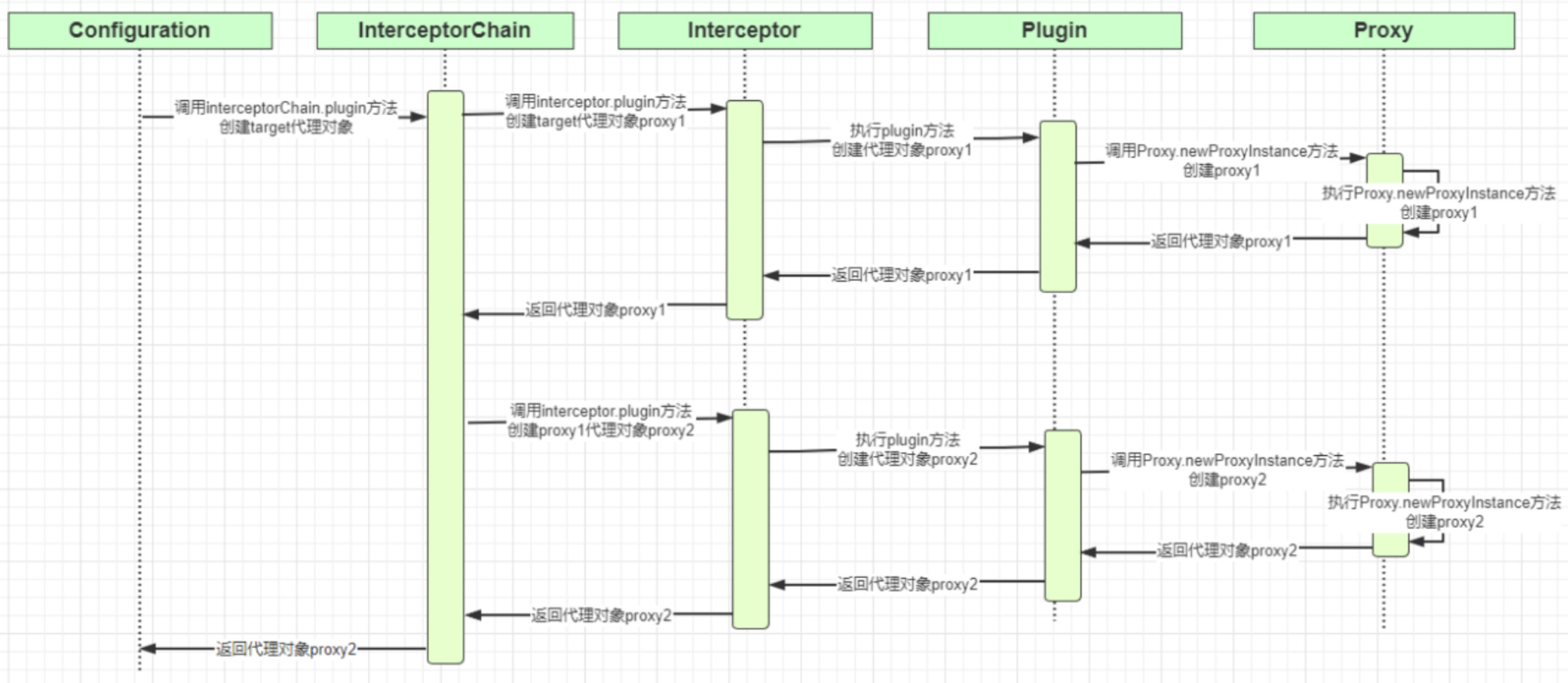
(1)一个对象被代理很多次
问题:同一个组件对象的同一个方法是否可以被多个拦截器进行拦截?
答案是肯定的,所以我们配置在最前面的拦截器最先被代理,但是执行的时候却是最外层的先执行。
具体点:
假如依次定义了三个插件: 插件1 , 插件2 和 插件3 。
那么List中就会按顺序存储: 插件1 , 插件2 和 插件3 。
而解析的时候是遍历list,所以解析的时候也是按照: 插件1 , 插件2 , 插件3 的顺序。
但是执行的时候就要反过来了,执行的时候是按照: 插件3 , 插件2 和 插件1 的顺序进行执行。
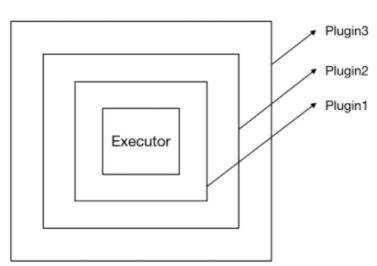
当 Executor 的某个方法被调用的时候,插件逻辑会先行执行。执行顺序由外而内,比如上图的执行顺序为 plugin3 → plugin2 → Plugin1 → Executor 。
写在后面
如果本文对你有帮助,请点赞收藏关注一下吧 ~

更多推荐
 已为社区贡献13条内容
已为社区贡献13条内容










所有评论(0)